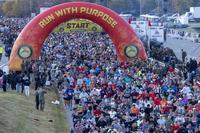Do you want a better physical fitness test (PFT) score? Statistically speaking, most people's biggest issue when preparing for a PFT is inefficient pacing and conditioning/technique. Running and swimming require three things to perform optimally: technique, conditioning and pacing strategy.
Here is a question from a special ops candidate who has to do both the 500-meter swim and the 1.5-mile timed run in his fitness test:
Stew, I think my biggest thing with my running and swimming is simply learning to pace myself. I'm sure you see it all the time with guys and their PST scores, where they just come blaring out of the gate. I've got to fix the same thing with my non-fin swimming so I can learn the right amount to hold back in the beginning. Fin swimming is good to go; I can maintain pace for distance with a pretty calm effort, with no joint or muscular stress from the jet fins afterward. Any suggestions? -- Shane
Shane, good question. Yes, I agree that the first lap or two can crush your overall time if you start off too fast on a timed swim or run. So, yes, focus on goal pace.
Create a test-taking strategy. The last thing you want to do is show up for your first fitness test with a military special-ops recruiter/mentor and fail, because you never have practiced it before. Believe it or not, there are recruits who show up to a 500-yard swim not knowing whether they will finish it their first time. That is no way to have a spec-ops job interview. You have to consider these fitness tests with recruiters/mentors as "job interviews," as they are your first entrance exam. They matter.
In order to build a strategy that works for you, you have to learn how to take this test by actually taking the test. You should know how it feels to run at your pace and to swim at your pace to yield the scores you want. You also should know that you will need more fuel by the latter half of the fitness test, as you tend to run out of gas just when you need it for the last event, the 1.5-mile run test. See nutrition for fitness
Here is how to develop your test-taking strategy by learning your pace and training for your pace with events like running and swimming.
Same pacing workout with swimming: (Do this 5-6 times a week)
Warm up with 500-yard combat swimmer stroke (CSS) or freestyle (a mix is fine, too) nonstop. When you "warm up" with a 500-yard or 500-meter swim, you are training to make the 500-meter swim "nothing more than a warmup." This is more of a psychological benefit, but it will get you more prepared for swimming 500 meters at a fast pace.
After the warmup, do the following 50/50 split workout:
Repeat 10 times
50-meter swim freestyle fast (6-8 strokes per breath)
(No rest) 50-meter swim CSS at your goal pace*
Rest 10 seconds before starting again
*Goal pace swimming will depend on your abilities, but a good standard is a yard or meter per second. Most military swim tests are 500 yards or 500 meters. Shoot for a yard per second and score 500 seconds, which is an above-average score of 8:20. This is good enough (actually above average) for most military programs, even special ops-level swimming.
Do this swim workout 5-6 days a week. The minimum standard daily is 1,000-1,500 meters, period, if you want to get in shape to swim 500 meters fast.
For running, the same type of program works, but you can add in a sprint workout 1-2 times a week if you prefer. If your conditioning is solid, focus on goal pace for a few weeks as your only running workout every day (4-5 times a week).
Running workout #1 (2.5 miles total distance)
Run one-mile warmup/stretch
Repeat 6 times
400 meters at goal mile pace (example 1:30 = 9 minutes, 1.5-mile goal pace)
Rest with one-minute calisthenics (squats, lunges, push-ups, sit-ups -- your choice, depending on upper-body or lower-body days). Or if you want to just focus on running, rest with a one-minute walk.
Run one-mile cooldown/stretch. Mix in a few sprints if you prefer, with slow jog intervals.
Running workout #2 (3 miles total distance)
Run one-mile warmup/stretch
Repeat 4 times
800 meters at goal mile pace (example, 3 minutes = 9 min, 1.5-mile goal pace)
Run one-mile cooldown/stretch. Mix in a few sprints if you prefer, with slow jog intervals.
More running ideas:
Stew Smith is a former Navy SEAL and fitness author certified as a Strength and Conditioning Specialist (CSCS) with the National Strength and Conditioning Association. Visit his Fitness eBook store if you’re looking to start a workout program to create a healthy lifestyle. Send your fitness questions to stew@stewsmith.com.
Want to Learn More About Military Life?
Whether you're thinking of joining the military, looking for fitness and basic training tips, or keeping up with military life and benefits, Military.com has you covered. Subscribe to Military.com to have military news, updates and resources delivered directly to your inbox.
















